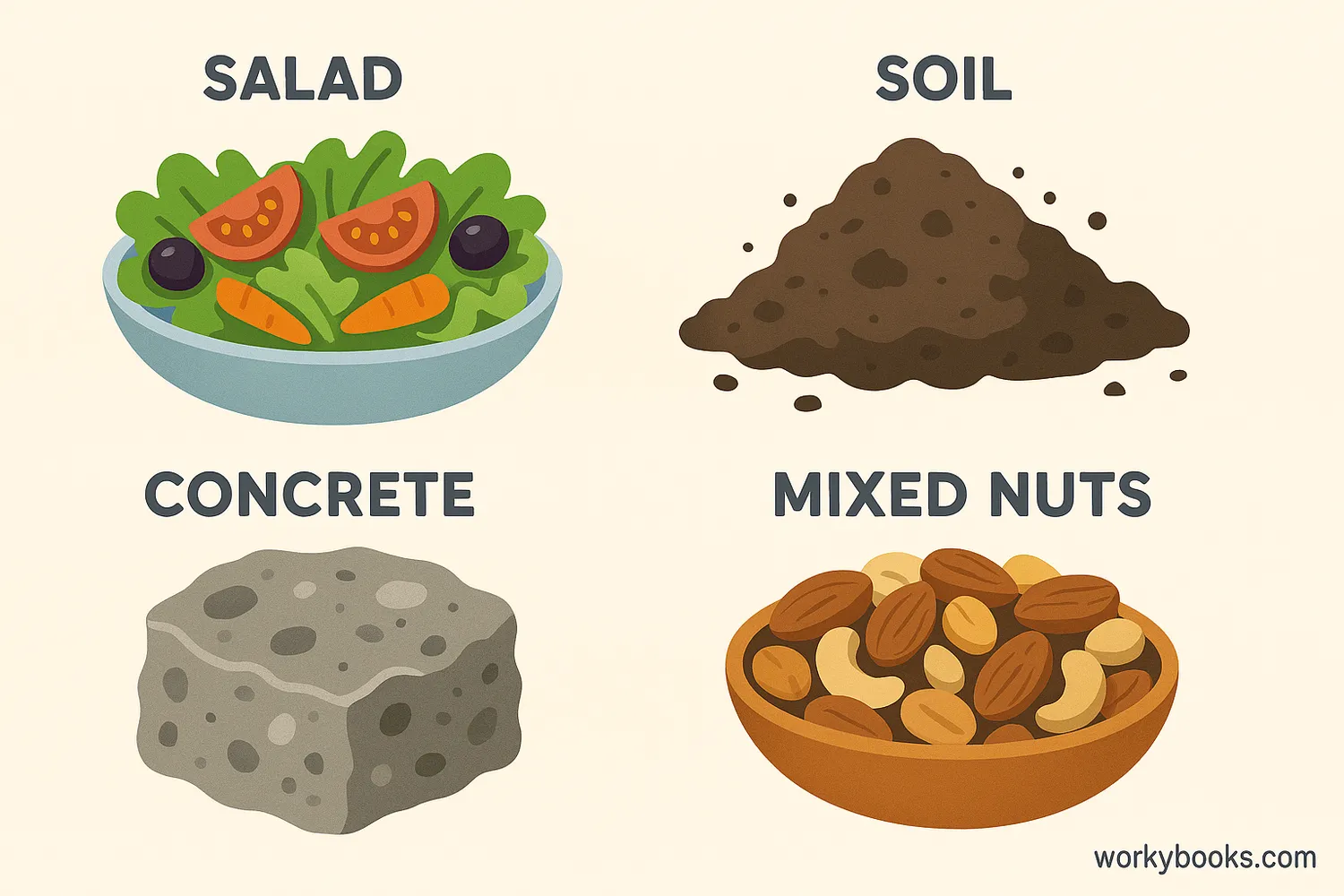Heterogeneous Mixtures - Definition, Examples, Quiz, FAQ, Trivia
Discover how different types of matter combine while keeping their unique properties
What is a Heterogeneous Mixture?

A heterogeneous mixture is a type of mixture where the different components are not evenly distributed throughout. This means you can usually see the different parts with your eyes or under a microscope. The prefix "hetero-" means "different," which helps us remember that heterogeneous mixtures contain visibly different substances.
Think of a salad or a bowl of cereal with milk. You can see the different ingredients like lettuce, tomatoes, and cucumbers in a salad, or the cereal pieces floating in milk. Each part keeps its own properties, even when mixed together.
Key Point
In heterogeneous mixtures, you can usually see the different parts, and they can often be separated physically (like picking tomatoes out of a salad).
Examples of Heterogeneous Mixtures

Heterogeneous mixtures are all around us in everyday life. Here are some common examples:
Salad
Lettuce, tomatoes, cucumbers, and other ingredients mixed together but still visible
Soil
Contains sand, silt, clay, organic matter, and small rocks that you can see separately
Concrete
Made of cement, sand, gravel, and water - you can often see the different components
Chocolate Chip Cookies
The dough and chocolate chips are visibly different components
Rocky Road Ice Cream
Contains ice cream, marshmallows, and nuts that you can see and identify separately
These examples show how heterogeneous mixtures are part of our daily lives. The key characteristic is that you can see the different components that make up the mixture.
Heterogeneous vs Homogeneous Mixtures
It's important to understand the difference between heterogeneous and homogeneous mixtures. While heterogeneous mixtures have visibly different parts, homogeneous mixtures have the same composition throughout.
| Characteristic | Heterogeneous Mixture | Homogeneous Mixture |
|---|---|---|
| Composition | Not uniform throughout | Uniform throughout |
| Visibility of components | Components are visible | Components are not visible |
| Separation | Can be separated physically | Hard to separate physically |
| Examples | Salad, soil, concrete | Salt water, air, vinegar |
Remember
"Hetero" means different (you can see the differences), while "homo" means same (it looks the same throughout).
Types of Heterogeneous Mixtures
Heterogeneous mixtures can be classified into different types based on the size of their particles and how they behave:
Suspensions
Mixtures where solid particles are suspended in a liquid but will settle over time (like sand in water)
Colloids
Mixtures with intermediate-sized particles that don't settle but scatter light (like milk or fog)
Coarse Mixtures
Mixtures with large particles that are easily visible (like trail mix or granite rock)
Understanding these different types helps scientists classify and study mixtures based on their properties and behaviors.
Mixture Quiz
Test your knowledge about heterogeneous mixtures with this quiz! Answer all 5 questions to see how much you've learned.
Frequently Asked Questions
Here are answers to some common questions about heterogeneous mixtures:
Science Trivia
Discover some interesting facts about mixtures and matter!
Natural Mixtures
Granite is a natural heterogeneous mixture found in the Earth's crust. It contains visibly different minerals like quartz, feldspar, and mica that cooled slowly beneath the Earth's surface.
Cosmic Mixtures
Saturn's rings are a gigantic heterogeneous mixture in space! They're made of countless particles ranging from tiny dust grains to large boulders, all orbiting the planet together.
Tasty Mixtures
The first known trail mix was created in 1968 by two California surfers who blended peanuts, raisins, and chocolate chips for an energy snack during their expeditions.
Ancient Mixtures
Concrete, one of the most common heterogeneous mixtures, was used by ancient Romans over 2,000 years ago. Some Roman concrete structures still stand today!


